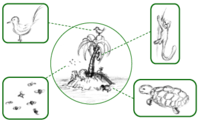
Photo from wikipedia
Abstract The computational fluid dynamics (CFD) method based on solving the Reynolds-averaged Navier-Stokes equations was used to simulate the flow field of the body-wave interaction. A dynamic mesh strategy, which… Click to show full abstract
Abstract The computational fluid dynamics (CFD) method based on solving the Reynolds-averaged Navier-Stokes equations was used to simulate the flow field of the body-wave interaction. A dynamic mesh strategy, which combines the sliding interface technique and the dynamic layering technique, was adopted to handle the mesh update due to the body motion in the simulation. This mesh strategy was capable of treating the arbitrary translational and rotational motions of the body. To validate its performance, the mesh strategy was implemented with the CFD solver ANSYS-Fluent and was applied to solve the 2-D problem of a freely floating box-shaped structure subjected to the focused wave. The present numerical results were compared with the published experimental data and numerical results. For the case of wave generation, the present dynamic mesh strategy incurred 4% loss in accuracy and 6% loss in efficiency compared to the static mesh strategy. For the case of body-wave interaction, the accuracies of the present dynamic mesh strategy and the dynamic overset mesh technique were at the same level. In addition, an application of the present dynamic mesh strategy to the 3-D simulation of a damaged ship capsizing in regular beam wave was demonstrated.
Journal Title: Ocean Engineering
Year Published: 2019
Link to full text (if available)
Share on Social Media: Sign Up to like & get
recommendations!